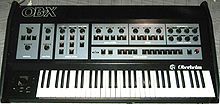This article needs additional citations for verification. (February 2021) |
| OB-X | |
|---|---|
 Oberheim OB-X | |
| Manufacturer | Oberheim |
| Dates | 1979–1981 |
| Price | US$4,595–US$5,995 |
| Technical specifications | |
| Polyphony | 4, 6 or 8 voices |
| Timbrality | Monotimbral |
| Oscillator | 2 VCOs per voice |
| LFO | 1 |
| Synthesis type | Analog Subtractive |
| Filter | 12dB per octave resonant low-pass |
| Attenuator | 2 × ADSR; one for VCF, one for VCA |
| Aftertouch expression | No |
| Velocity expression | No |
| Storage memory | 32 patches |
| Effects | None |
| Input/output | |
| Keyboard | 61-key |
| External control | CV/Gate |
The Oberheim OB-X was the first of Oberheim's OB-series polyphonic analog subtractive synthesizers.[1][2]
First commercially available in June 1979, the OB-X was introduced to compete with the Sequential Circuits Prophet-5, which had been successfully introduced the year before.[3] About 800 units were produced before the OB-X was discontinued and replaced by the updated and streamlined OB-Xa in 1981. The OB line developed and evolved after that with the OB-8[4] before being replaced by the Matrix series.
The OB-X was used in popular music by Rush (on Moving Pictures and Signals), Nena, Styx member Dennis DeYoung (used frequently from late 1979 to 1984), Queen (their first synthesizer on an album), Madonna for her debut album, Prince,[5] and Jean-Michel Jarre who used it for its "brass" sounds.
- ^ Vail, Mark (1993). Vintage Synthesizers. San Francisco, California: Miller Freeman Books. p. 154. ISBN 0-87930-275-5.
- ^ "Synth Icons: Oberheim OB Series". Music Radar.
- ^ Forrest, Peter (1996). The A-Z of Analogue Synthesizers Part Two: N-Z. Devon, England: Susurreal. p. 20. ISBN 09524377-1-6.
- ^ Colbeck, Julian (1996). Keyfax Omnibus Edition. Emeryville, California: MixBooks. pp. 89–90. ISBN 0-918371-08-2.
- ^ "Oberheim OB-X". Guitarcloud - Prince Equipment Archive.